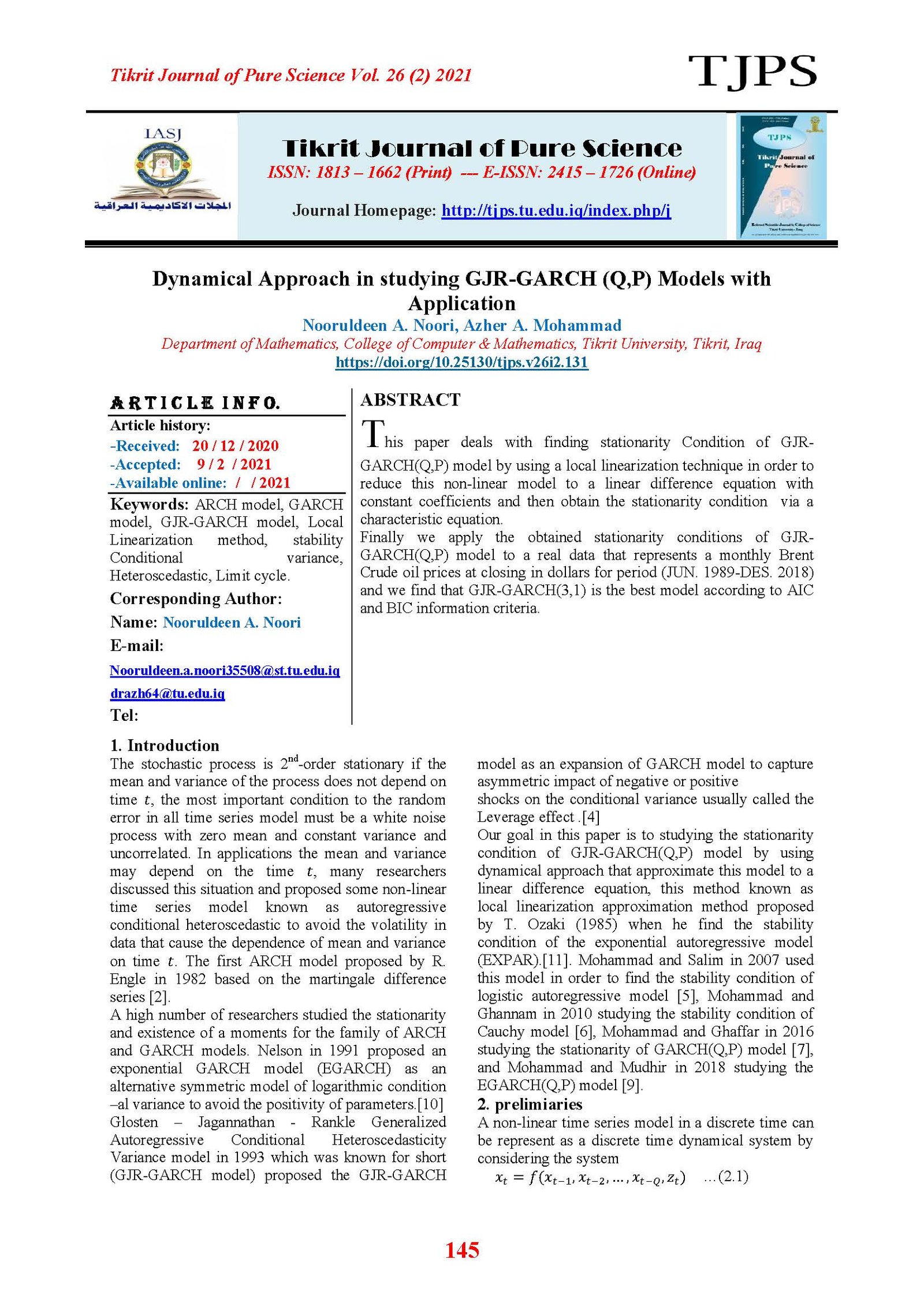Dynamical Approach in studying GJR-GARCH (Q,P) Models with Application
Main Article Content
Abstract
This paper deals with finding stationarity Condition of GJR-GARCH(Q,P) model by using a local linearization technique in order to reduce this non-linear model to a linear difference equation with constant coefficients and then obtain the stationarity condition via a characteristic equation.
Finally we apply the obtained stationarity conditions of GJR-GARCH(Q,P) model to a real data that represents a monthly Brent Crude oil prices at closing in dollars for period (JUN. 1989-DES. 2018) and we find that GJR-GARCH(3,1) is the best model according to AIC and BIC information criteria.
Article Details

This work is licensed under a Creative Commons Attribution 4.0 International License.
Tikrit Journal of Pure Science is licensed under the Creative Commons Attribution 4.0 International License, which allows users to copy, create extracts, abstracts, and new works from the article, alter and revise the article, and make commercial use of the article (including reuse and/or resale of the article by commercial entities), provided the user gives appropriate credit (with a link to the formal publication through the relevant DOI), provides a link to the license, indicates if changes were made, and the licensor is not represented as endorsing the use made of the work. The authors hold the copyright for their published work on the Tikrit J. Pure Sci. website, while Tikrit J. Pure Sci. is responsible for appreciate citation of their work, which is released under CC-BY-4.0, enabling the unrestricted use, distribution, and reproduction of an article in any medium, provided that the original work is properly cited.
References
[1] Bollerslv, T. (1986). Generalized autoregressive conditional heteroskedasticity. journal of Econometrics, 31(3):307-327.
[2] Engle, R.F. (1982). Autoregressive Conditional Heteroscedasticity with Estimates variance of United Kingdom Inflation. journal of Econometrica, 50 (4): 987–1008.
[3] Francq, C. and Zakoian, J. M. (2019).GARCH Models: Structure. Statistical Inference and Financial Applications.2nd edn., John Wiley and Ltd Publication:492 pp.
[4] GLOSTEN, L.R. ; JAGANNATHAN, R. and RUNKLE, D.E. (1993). On the Relation between the Expected Value and the Volatility of the Nominal Excess Return on Stocks. The Journal of Finance, 485 (5): 1779–1801.
[5] Mohammad , A.A. and Salim, A.J. (2007). Stability of Logistic Autoregressive model. Qatar Univesity of scince journal, 27:17–28.
[6] Mohammad, A.A. and Gannam, A.K. (2010). Stability of Cauchy Autoregressive model. journal of pure and applied scince, Salahaddin University Hawler (special Issue):52-62.
[7] Mohammad, A.A. and Ghaffar, M.K. (2016). Astudy on stability of Conditional variance for GARCH models with application. Tikrit journal of pure scince, 21 (4):160-169.
[8] Mohammad, A.A. and Mudhir, A.A. (2018). Dynamical approach in studying stability condition of exponential (GARCH) models. Journal of King Saud University - Science, Vol.32 (1):272-278.
[9] Mohammad, A.A. and Salim, A.J. (1996). The Analysis and Modeling of the time series of annual mean temprature in Mosul City. Rafidain Journal of Science,7 (1): 37-48.
[10] Nelson, D.B. (1991). Conditional Heteroskedasticity in Asset Returns: A New Approach”, Econometrica, 59 (2):347-370.
[11] Ozaki, T. (1985). Non-linear time series models and Dynamical systems. Handbook of statestics. Hannen et al. Elsevier science publishers Rv ,5 (S):25–83.
[12] Wiphatthanananthakula, C. and Sriboonchittab, S. (2010). The Comparison among ARMA-GARCH, -EGARCH, -GJR. The Thailand Econometrics Society journal, 2 (2):140–148.
[13] Yuan Chen, M. (2013).Time series Analysis: Conditional Volatility models. Dep. of Finance. National chung Hsing University: 1-42 pp
